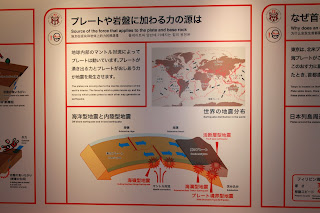On Tuesday we visited river improvement areas near Shirakogawa and Shakujigawa in Western Tokyo.
With the skies being at their utmost clarity, we could see Mount Fuji from the bus (zoom in on the largest cloud shape to see it). It's hard to imagine I was standing on top of it a mere four months ago. Capturing the mountain provided a good morning bus ride activity, after which we arrived at the Tokyo Metropolitan Government Planning Section River Department Construction Bureau. (They do like to use multiple lines on business cards.) Aside from highly informative lectures - did you know Tokyo receives twice the global mean annual rainfall? - we got to see the improvement constructions ourselves. It was something altogether unexpected.



I had no idea another underground basin was in store for us. It appears to be bigger than the last basin at the G-Cans, but it is hard to estimate volume in a three dimensional maze like this. There were some small differences in maintenance compared to the G-Cans as well, aside from the multitude of pillars used here. There are air vents running halfway through the hall, water can flow onto the electrical system of the pumps, there is water running through cracks in the ceiling, and strung around the water entrances are CD's failing to deter pigeons.







After having another look at the downstream flood control reservoir, but now from the outside, we went on to the construction site of the new underground shaft at Shirogawa. A second shaft at Shakujigawa and a connecting tunnel have yet to be finished, but here comes the biggest difference with the G-Cans: due to flooding at both Shirogawa and Shakujigawa sites, it has been decided to finish the design in such a way that the water can enter and exit at both ends! Engineering gemstones, that.



We went on to the upstream reservoir. Slightly less deep to avoid draining water from surrounding hills, it doubles as a tennis court and soccer field. We also witnessed the enlargement of river revets, aka concrete dikes holding the water in place. The unfortunately necessary trimming of sakura trees aligning the river was taken into account in the construction plans, of course. Final point to note is the exceptional handling of the Shirakogawa, as it lies in two prefectures instead of one (most rivers lie in only one prefecture; it saves a lot of hassle). Saitama and the Tokyo Metropolitan Government are performing joint planning and agreed on a design level of 50 mm/hour rainfall for this river. Allegedly there are joint decisions and many communications, though I have only heard this from one party. Theory and practice in governance, and most importantly the definition of responsibilities, can differ a lot here. It was a great opportunity to see joint plans put into action though.
























































